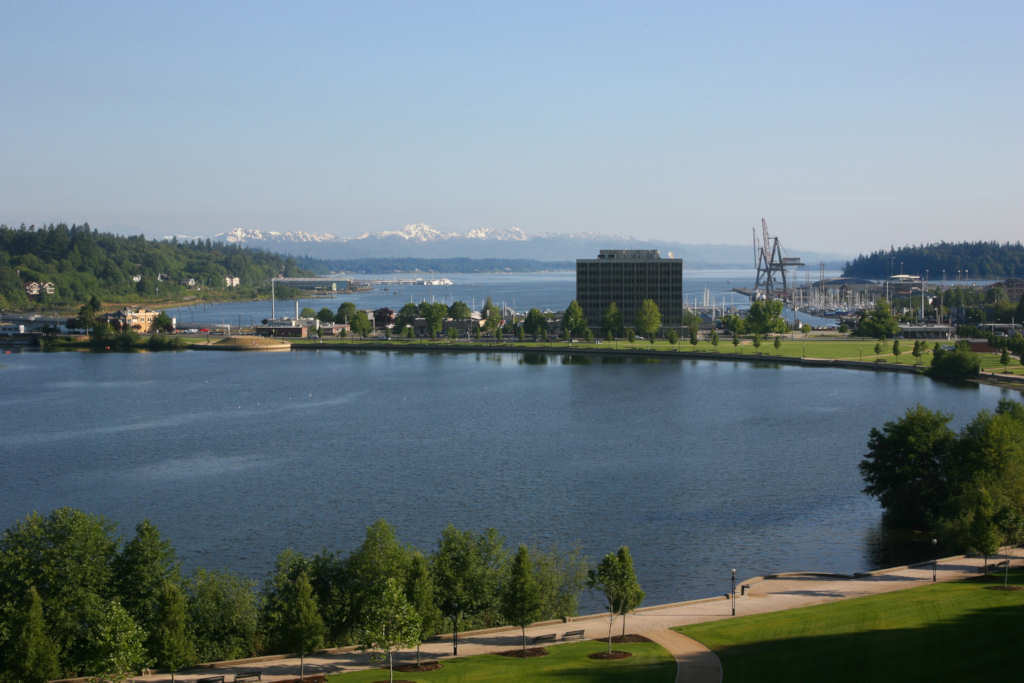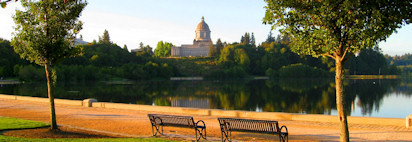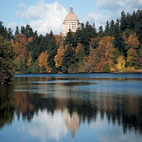Budd Inlet Model Analysis
by Dr. David H Milne, PhD - February 2016
The Executive Summary and the Recomendations sections below are parts of Dr. Milne's 79 page report. For detailed information, see bottom of this page for links to the complete report either in separate PDF sections or as a single PDF file.
Executive Summary
The Washington Department of Ecology’s Report, “Supplementary Modeling Scenarios” purports to demonstrate that Capitol Lake’s effect on Puget Sound lowers the dissolved oxygen content of Sound waters and is responsible for violations of water quality standards there. That Report presents outputs of a complex computer simulation, the “Budd Inlet Model”, that are said to support its authors’ claims. That is not the case. In fact, errors and short-comings aside, data in that Report, not recognized even by its authors, support the view that Capitol Lake’s effects on Puget Sound are actually beneficial.
The WSDOE Supplementary Modeling Scenarios Report is available through the DOE summary page and the report PDF (96 pg)
The following problems with the Report are noted. There are other problems, too many for a single page summary.
- 1) Water Quality standards violations in Capitol Lake itself were vastly overestimated;
- 2) The calculations of Total Organic Carbon (from plant growth) entering the Sound from the Lake or Estuary scenarios overstate the amount of TOC in the Lake case and understate it in the Estuary case;
- 3) An inappropriate technique was used to calculate East Bay water residence times;
- 4) The authors mistakenly assume that Capitol Lake’s ecology is phosphorus limited and base several pages of irrelevant discussion and calculation on that assumption;
- 5) The Budd Inlet model produces many demonstrably wrong answers where compared with observed data; yet the authors consider every dissolved oxygen calculation accurate to within 0.2 mg/L;
- 6) Answers derived from the authors’ method of finding water quality standards “violations” (based on calculated unknown/unknowable conditions in hypothesized pre-modern waters) are not subject to independent confirmation or refutation (not testable) by scientists elsewhere;
- 7) The authors’ hypothesis of how organic carbon created by plants in the Lake enter and affect Budd Inlet is not ecologically realistic and, contrary to their claim, is not testable by the Budd Inlet model;
- 8) A Figure showing water quality violations in the hypothesized pre-modern (pre-dam) estuary is formatted in a way that makes it impossible to judge the extent of the violations; proper formatting shows that violations are as widespread in that “natural” water (and comparable in size) as they are today with Capitol Lake present;
- 9) There is no Figure showing violations in the modern water if the dam were not present – a critical omission making it impossible to see whether that “estuary scenario” would be better or worse than the “lake scenario;”
- 10) The authors avoided simulating the effect on the Lake/Inlet interaction that would result from a program of harvesting Lake plants, an option that might improve Inlet water quality;
- 11) The authors avoided simulating the Lake’s effect on the Inlet if nutrient nitrogen levels in the Deschutes River were reduced, an option that might improve Inlet water quality;
- 12) Figures included from other sources, said to bolster the authors’ claim, actually show the opposite; beneficial removal by Capitol Lake of nutrient nitrogen from Deschutes River water.
No public policy decisions should be based on the contents of the Supplemental Modeling Report.
Recommendations
These recommendations for further refinement of the Budd Inlet simulations were presented to WDOE staff during a meeting in November, 2014
PDF version available in Appendices section or complete PDF version (both listed below)
- 1) Simulate the inlet between dates March 15 and October 15. Some WQ standards violations occur after Sept. 15, the present cut-off date of the simulation. There are none before March 15.
- 2) Change the present unconventional practice of reporting model outputs (as a single unspecified depth on a single unspecified date showing the maximum level of WQ standards violation for the duration of the simul-ation) to showing a vertical profile of DO on the date(s) of the violations. If im¬prac¬tical for all violation locations, at least do so for violations at stations reported in the BISS data. It is presently impossible to compare the model outputs with observed data. The present mode of reporting precludes conventional interpretation by aquatic ecologists.
- 3) Always report the 90% confidence limits on estimates of the size of WQ stds violations. Estimates of unknown values of DO’s in nature may or may not be far off the mark. Confidence limits put such estimates in perspective.
- 4) Use as the criterion for identifying WQ stds violations whether or not the upper confidence limit (not the estimate itself) falls below the WQ standard. If the upper confidence limit falls below the standard, we may be very sure that there really is a violation. Especially if it is an UCL of a mean of several estimates.
- 5) For validation of whichever model is used, calculate dissolved oxygen vertical profiles for all the BISS stations, on the same dates as the BISS stations were observed and at the same times of day. These stations, dates, and times are available in the BISS data spreadsheet. This makes a crucial model validation test possible. This calculation is critical to determining whether the model replicates the structure of Budd Inlet water or not.
- 6) Find a way to extend the Budd Inlet model’s “view” into the water beyond Boston Harbor, or use the larger South Sound model for the simulations. It appears that significant Estuary Scenario effects occur right up to the edge of the Budd Inlet model’s domain. For accurate simulations of Estuary Scenarios, it is essential that the water beyond Boston Harbor be brought into the simulation.
- 7) Articulate the perceived problems to be fixed when modifying the model, and what constitutes “success.” [I am thinking of the poster. Maybe this has already been done, I lost my copy! If so, good work.]
- 8) It would be helpful if model output maps show the calculated DO’s of water in the bottom layer over the whole of Budd Inlet at representative dates. The bottom layer is almost always the place where DO goes lowest. This would provide valuable overviews of the situation at the bottom.
This complete analysis and individual sections are available in PDF format.
PDF files are best viewed in any browser or PDF reader EXCEPT Miscrosoft "Edge" browser.
All PDF files below contain "bookmarks" for easy reading.
- Outline & Index (4 pg)
- Executive Summary (1 pg) The "Budd Inlet Model" Report actually supports the view that Capitol Lake’s effects on Puget Sound are beneficial. (This summary is shown above)
- 1 Introduction (10 pg) Introduces the computer simulation that calculates effects of changes on Budd Inlet
- 2 The Computer gets Many Wrong Answers (11 pg) Only about half of the computer’s oxygen level calculations are accurate.
- 3 Simulted & Real Roles of Organic Carbon (15 pg) In realistic scenarios, the Lake puts far less TOC into the Sound than would an estuary.
- 5 Capitol Lake Protects Budd Inlet (13 pg) Exposes minor errors and WDOE’s failure to show negative estuary DO features
- 6 Alternative Hypothesis (8 pg) Late season departure of organic carbon from Capitol Lake: an alternative hypothesis
- 7 Capitol Lake Errors& Mis-Characteriztions (10 pg) Disproves WDOE’s claim that Capitol Lake has "oxygen depletion."
- 8 References (3 pg) Sources of information used to compile this Analysis
- 9 Appendices (3 pg) Recommendations to WDOE staff and a source of data. (Includes the recommendations shown above.)
The WSDOE Supplementary Modeling Scenarios Report is available through the DOE summary page and the report PDF (96 pg)
Budd Inlet Model Analysis
by: Dr. David H Milne February 2016An analysis of the use and misuse of the Budd Inlet model, and how Capitol Lake protects Budd Inlet.


